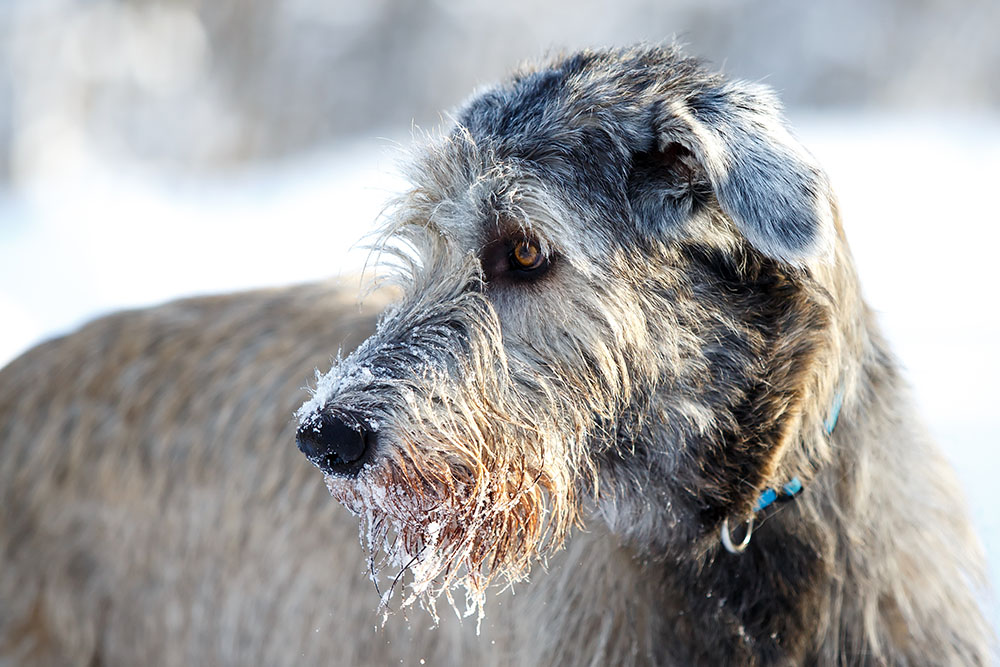Breed Profile – Irish Wolfhound
29/01/2018
The tallest dog breed in the world, the Irish Wolfhound is a sight hound with an interesting history. Whilst it might be the biggest, it’s also one of the gentlest and certain to increase your food bill!
History of Breed: As its name suggests, the Irish Wolfhound was developed in Ireland to hunt wolves. It’s Irish name is Cu Faoil, ‘cu’ meaning hound and a prefix added to the names of warriors or kings to show that they deserved the respect and loyalty of a hound. Irish Wolfhounds were historically only owned by nobles, i.e. the British, so were unpopular as a national symbol with Republicans. They chose the Kerry Blue Terrier instead. The breed is, however, the mascot for the Irish Guards.
The origin of the Irish Wolfhound is thought to lie in a greyhound-type brought by the Phoenicians to Ireland. These were crossed with mastiff-type dogs to produce a dog fast enough and strong enough to see off the wolves that threatened Irish livestock. There were no wolves in Ireland by the end of the 18th century and numbers of Irish Wolfhounds dwindled almost to extinction. Scotsman Captain Graham led a group devoted to reviving the breed. The breed as we know it today differs slightly from the original Wolfhound. It is a combination of Deerhound, Great Dane and Tibetan Mastiff that retains the essential characteristics of the breed: speed, strength, size and gentle nature.
Life Expectancy: Around 8 years.
Size: Large, with a height range of 71-86cm and a weight range of 48-68kg.
Features: Characterised by its great size and rough coat, the Irish Wolfhound’s length should be in proportion to its height. It has a long back and deep chest with muscular shoulders, thighs and forelegs. The long neck and head allow this sight hound to visualise the landscape with dark, intelligent eyes. The rough coat comes in a range of colours including white, grey, black, brindle, red, fawn and wheaten.
Energy Levels/Exercise Required: A high energy breed, bred for long days hunting, with lots of stamina and an amazing turn of speed. The Irish Wolfhound requires more than two hours exercise every day. This exercise should reflect its natural hound instincts to chase or ‘course’ if possible.
Potential Health Problems: Dilated cardiomyopathy and bone cancer are the commonest causes of death for this breed. Wolfhound puppies have a rapid growth period and owners should avoid supplements around this time. They should be fed a good quality adult dog food, such as Dr John Gold, which caters to large and giant breeds. It has the appropriate protein level (20%) to support dog health without encouraging rapid growth. A good alternative, with the same 20% protein level, is Gilpa Kennel. As with all deep-chested breeds, bloat is a serious cause for concern. Also known as gastric torsion or gastric dilatation volvulus, bloat can be fatal if not treated early.
Temperament: Intelligent, protective of owners, gentle and loyal, this breed needs firm but positive training from an experienced owner. They become very attached to their owners and dislike long periods of solitude away from them. This is one of the few occasions when they can develop a behavioural problem, being generally a calm, quiet breed. They are more likely to be protective of owners rather than property or possessions. They enjoy working independently and remotely rather than following direct instructions with their owner close by.
Family Dog/Child Friendly: The Irish Wolfhound might be big, but it is gentle and is actually very good with children. Supervision is always a good idea when it comes to dogs and children. This is especially true with very large dogs to avoid the risk of inadvertent crushing, however gentle the dog is. Wolfhounds are happiest in a large rural house with plenty of outdoor space to run off excess energy.
Likes: Exercise linked to natural instincts, companionship with owners.
Dislikes: Solitude, lack of exercise, strangers, provocation.



